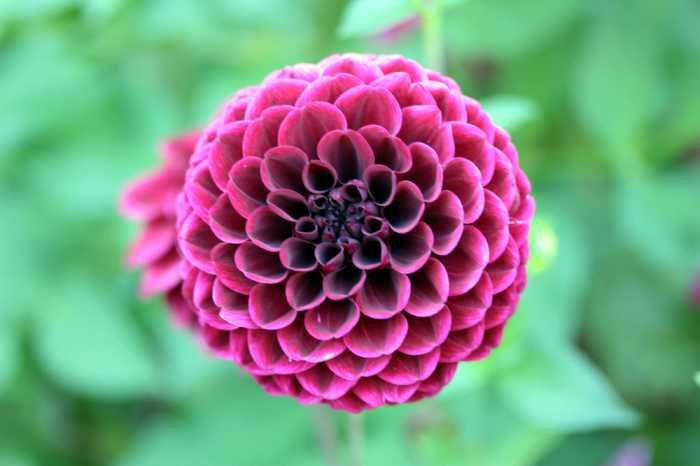The day of the dahlia

PHUKET: Thais are seriously superstitious. There are lucky days when big decisions must be made and unlucky days when everything must be put on hold. Lotteries are a national obsession. Ghostly presences haunt every soap opera, bringing misfortune to those who fall foul of them. Good or bad karma is part and parcel of daily experience.
There are, predictably, a host of so-called “lucky plants” – for example braided money trees nicknamed “the bringer of good fortune”, jade plants (crassula ovata), mistletoe figs, euphorbia millii (crown of thorns) and the extraordinarily named zamioculcas. All these are commonly found in pots fronting Thai properties.
Indoors you may also encounter a lucky bamboo – actually dracaena sunderiana. Not just attractive presences, but harbingers of good fortune. There are even lucky floral garlands, that, draped from your rear view mirror, will protect you and your vehicle’s passengers.
Unlucky plants? Yes, they too exist, though in some cases, a change of name has their image. Thus the plumeria or frangipani was originally known in the kingdom as lantom, an epithet connoting sadness: old people forbade its ill-starred presence in their homes or gardens. Its image was not helped either by the fact that these trees were often planted in Muslim graveyards. Nowadays, the common and much sprightlier name accorded the shrub by Thai horticulturalists is leelawadee.
A similar mutation could transform the status of the dahlia. In a recent informative article, Normita Thongtham pointed out that the dahlia used to be known in Thailand as rak rae or “unstable love”, an unfortunate association, especially for a superstitious wife fearful of her husband’s potential infidelity.
Now the name, like that of the plumeria’s, has been changed to rak raeg or “first love” in an attempt to bolster the plant’s popularity. I had always assumed that dahlias, one of the world’s most attractive and varied herbaceous perennials did not grow here because they could not cope with Phuket’s climate. But this is apparently by no means the whole story.
That dahlias deserve to be grown more widely in Thailand is undeniable. After all, they come from Mexico and Central America so they are more likely to flourish here than in areas such as the United States or Europe where they are massively popular. But they do need plenty of tender loving care.
Ideally, they require sandy, slightly acidic soil and plenty of water and sun. Moreover, they are heavy feeders and prefer a fertilizer with extra potash – say a 6-12-12 formula. They can be grown from seed, ideally in trays or pots sown about an inch apart and covered with a quarter inch of fine soil. They will need to be watered sparingly but regularly. Transplanted when a few centimeters tall or kept in large containers, they will bloom in as little as four months. Since they have heavy, succulent stems and weighty, often whopping blooms, dahlias will need to be staked, preferably early in their progress to maturity otherwise they are easily damaged by wind. In conditions here, I would suggest the best situation would be a sheltered spot with filtered sunlight.
The professional method of propagation is to use tubers. Dahlias, a member of the asteraceae family are atypical in that they produce large clumps of fleshy rhizomes, rather after the manner of canna lilies. After two years of display, carefully prise the whole clump out of the soil, and store in a clean, dry place until you want new plants. The clump should be separated with a sharp knife into individual tubers, ensuring that each tuber has at least one eye or growth point which, if left alone, will develop into a shoot. The cut area should be allowed to heal, then the tuber can be potted with the shoot pointing upwards. Pinching out the growing shoots just above a set of leaves, encourages a bushy habit and more flowers.
And what flowers. They vary in size from densely petalled half-inch pompoms to “dinner-plate” varieties which can measure up to a foot across. Shapes vary from single, daisy-like forms to double blooms, cactus or anemone shaped flowers, fimbriated ones with elegantly twisted petals, neat, ball-shaped flowers, and even ones that simulate the shape of water lilies. Many varieties possess flowers of two or more colors. No fewer than 99 varieties have been awarded the Royal Horticultural Award of Merit, whereas the National Collection in Cornwall consists of over 1,600 named species and cultivars.
Gardeners of Thailand, it’s time to catch up…
Tip of the Week: Relieving the pressure
I make no excuse for returning to the topic of potted plants. Thais have potted specimens in their front yards; expats on their condominium balconies and garden patios. Every garden center sells a variety of ceramic, plastic or concrete containers. But shrubs and herbaceous perennials grow so quickly here that they will need to be re-potted in bigger containers or divided after one or two years.
Why? Because the roots use up all the available space in the container. When you remove a root-bound plant, the ball will have shaped itself to the pot’s form and there may be as little as 20 per cent of the original potting mix left. And the main roots will have flattened themselves against the pot’s walls in a vain attempt to expand: as a consequence, there are no effective micro-roots on that side. Result: much reduced capacity to absorb water or nutrients.
If you have a question or a garden you want to see featured, email: drpaccampbell@gmail.com.
— Patrick Campbell
Leave a Reply
You must be logged in to post a comment.








